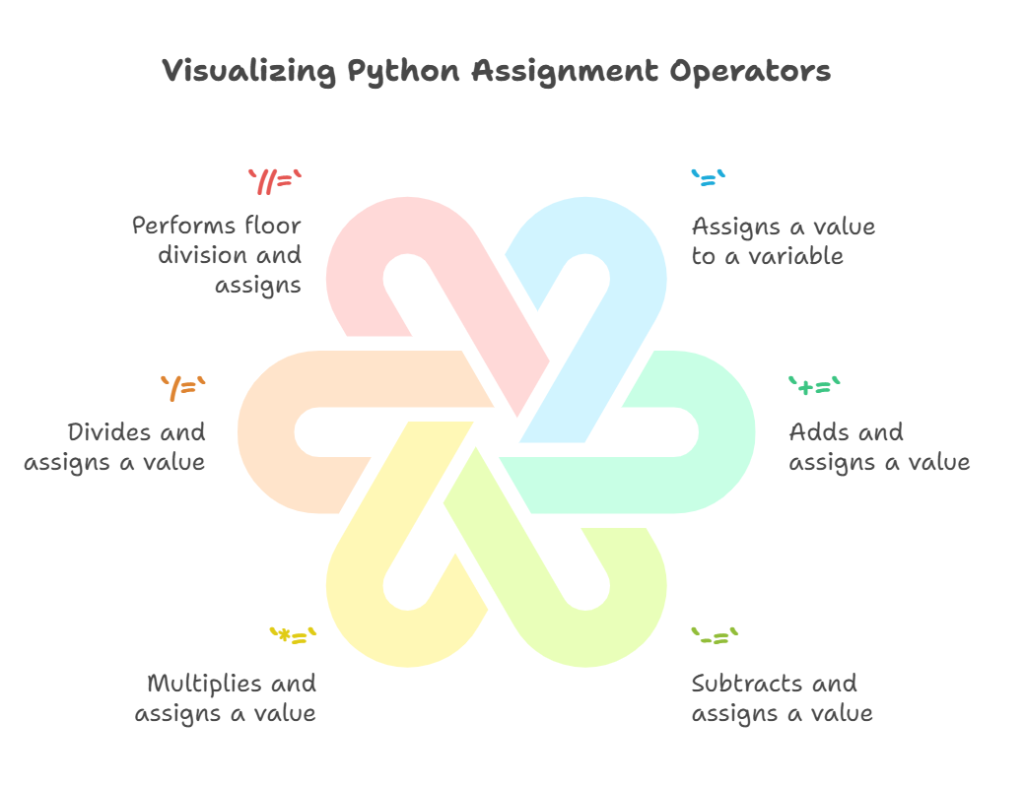Assignment operators in Python are used to assign or update values in variables. They simplify common tasks by combining mathematical operations with assignment, making code more concise and readable. In this comprehensive guide, we’ll break down assignment operators, their usage, and real-world applications, complete with examples, detailed explanations, and a mini-project.

Table of Contents
- What Are Assignment Operators in Python?
- Understanding Variable Assignment
- Types of Assignment Operators
- Basic Assignment (
=) - Arithmetic Compound Assignment (
+=, -=, *=, /=, %=) - Bitwise Assignment (
&=, |=, ^=, <<=, >>=)
- Basic Assignment (
- Practical Examples of Assignment Operators
- Mini-Project: Expense Manager
- Common Pitfalls and Best Practices
- Interview Questions and Answers (Google, Amazon, TCS, Infosys, Zoho)
1. What Are Assignment Operators in Python?
Assignment operators are special symbols used to assign values to variables. They work by taking the value on the right-hand side (RHS) and assigning or updating it in the variable on the left-hand side (LHS).
Why are they important?
- Simplifies code by combining operations.
- Reduces redundancy in mathematical and logical expressions.
- Offers better readability for developers.
2. Understanding Variable Assignment
Before diving into assignment operators, let’s understand variable assignment with a simple example:
x = 5 # Assigning value 5 to variable x print(x) # Output: 5
This process can be enhanced using compound assignment operators. Instead of writing x = x + 3, you can use x += 3. This saves time, reduces errors, and makes your code cleaner.
3. Types of Assignment Operators
a) Basic Assignment (=)
The = operator assigns a value to a variable. For example:
a = 10 b = "Hello" print(a, b) # Output: 10 Hello
This is the most commonly used assignment operator.
b) Arithmetic Compound Assignment Operators
These operators combine arithmetic operations (e.g., addition, subtraction, multiplication) with assignment.
| Operator | Description | Example |
|---|---|---|
+= | Add and assign | x += 5 |
-= | Subtract and assign | x -= 3 |
*= | Multiply and assign | x *= 4 |
/= | Divide and assign | x /= 2 |
%= | Modulus (remainder) and assign | x %= 3 |
Examples:
# Using arithmetic compound assignment x = 10 x += 5 # Adds 5 to x print(x) # Output: 15 x -= 2 # Subtracts 2 from x print(x) # Output: 13
c) Bitwise Assignment Operators
Bitwise operators work at the binary level, manipulating the bits of a number.
| Operator | Operation | Example |
|---|---|---|
&= | Bitwise AND and assign | x &= 3 |
| ` | =` | Bitwise OR and assign |
^= | Bitwise XOR and assign | x ^= 1 |
<<= | Left shift and assign | x <<= 2 |
>>= | Right shift and assign | x >>= 1 |
Examples:
x = 7 # Binary: 0111 x &= 3 # Binary: 0011 print(x) # Output: 3 (Binary: 0011)
Left and right shifts adjust the binary positions:
x = 5 # Binary: 0101 x <<= 2 # Shift left by 2 positions: 10100 print(x) # Output: 20
4. Practical Examples of Assignment Operators
Let’s combine multiple assignment operators in one program:
# Managing a bank account balance
balance = 1000 # Initial balance
# Deposit money
balance += 500 # Add $500
print("After deposit:", balance) # Output: 1500
# Withdraw money
balance -= 200 # Subtract $200
print("After withdrawal:", balance) # Output: 1300
# Apply interest (10%)
balance *= 1.10 # Multiply by 1.10
print("After interest:", balance) # Output: 1430.0
5. Mini-Project: Expense Manager
Objective
Create a simple program to track income, expenses, and calculate savings.
# Expense Manager
income = 0
expenses = 0
# Adding income
income += 3000 # Salary
income += 700 # Freelance job
# Adding expenses
expenses += 1000 # Rent
expenses += 200 # Groceries
expenses += 300 # Utilities
# Calculating balance
balance = income - expenses
# Results
print(f"Income: ${income}")
print(f"Expenses: ${expenses}")
print(f"Balance (Savings): ${balance}")
Output:
bashCopyEditIncome: $3700
Expenses: $1500
Balance (Savings): $2200
This program demonstrates real-world use cases for assignment operators.
6. Common Pitfalls and Best Practices
- Avoid overwriting variables unintentionally:pythonCopyEdit
x = 10 x += x # Be cautious; x becomes 20, not 10 - Use descriptive variable names:
Instead ofx, useincome,expenses, etc., for better readability. - Understand operator precedence:
Know the order in which operations are executed.
Interview Questions and Answers
Q: Can assignment operators work with lists in Python?
A: Yes, the += operator can concatenate lists, while other operators cannot.
Example:
list1 = [1, 2] list2 = [3, 4] list1 += list2 print(list1) # Output: [1, 2, 3, 4]
Amazon
Q: How does the >>= operator work with negative numbers?
A: For negative numbers, >>= shifts bits while retaining the sign.
Example:
x = -8 # Binary: ...11111000 x >>= 2 # Binary: ...11111110 print(x) # Output: -2
TCS
Q: How does += behave with strings?
A: The += operator concatenates strings.
Example:
s = "Hello" s += " World" print(s) # Output: Hello World
Infosys
Q: Write a program to calculate the power of a number using *=.
A:
base = 2
power = 3
result = 1
for _ in range(power):
result *= base
print(result) # Output: 8
Zoho
Q: Explain the use of multiple assignment in Python.
A: Python allows assigning multiple variables in one line.
Example:
a, b, c = 5, 10, 15 print(a, b, c) # Output: 5 10 15
aasignment operators
Question
Your answer:
Correct answer:
Your Answers
